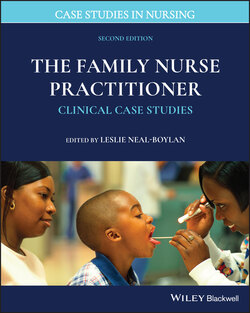Читать книгу The Family Nurse Practitioner - Группа авторов - Страница 30
ОглавлениеCase 3.5 Abdominal Pain
By Mikki Meadows‐Oliver, PhD, RN, FAAN
SUBJECTIVE
Four‐year‐old Jennifer presents to the office with a complaint of abdominal pain for 2 days. She is accompanied by her mother, Anat. Anat states that Jennifer’s pain is intermittent and is mainly on the left side of her abdomen. She states that the pain is sometimes worse after eating and that the pain is sometimes relieved by passing gas. Jennifer is unable to describe the quality of the pain, but Anat states that Jennifer will sometimes “double over” in pain. Jennifer has had no vomiting or diarrhea. She has had no cough or runny nose.
Diet: Jennifer’s nutrition history reveals that she eats bananas and rice almost daily. She drinks 4–5 cups of whole milk daily.
Elimination: She is voiding well with no complaints of dysuria. Jennifer has 2–3 bowel movements per week. Anat is unsure of the amount or consistency, since she rarely accompanies Jennifer into the bathroom.
Sleep: Jennifer sleeps approximately 10 hours at night. She has no problems falling asleep or staying asleep. Her sleep has not been interrupted by her abdominal pain.
Past medical history: Jennifer was born via cesarean section at 37 weeks’ gestation. Since being discharged at 4 days of age, she has had no emergency department visits or hospitalizations. Jennifer had bronchiolitis at 6 months of age but has had no injuries or illnesses since that time. Jennifer passed her developmental screening at her last well‐child visit. She currently attends prekindergarten and is doing well, according to Anat. She has no chronic illnesses and is not currently taking any medications.
Social history: Jennifer lives at home with both parents and a 2‐year‐old sibling. Her mother works as a nurse, and her father is a firefighter. The family has a pet chihuahua. There are no smokers in the home.
Family medical history: Jennifer’s mother (29 years old) and father (29 years old) are healthy and have no history of chronic medical conditions. Her 2‐year‐old sibling is healthy as well. Her maternal grandmother (52 years old) has a history of Crohn’s disease. Her maternal grandfather (54 years old) has a history of asthma. Jennifer’s paternal grandfather passed away at 47 years of age from stomach cancer. Her paternal grandmother (53 years old) has a history of obesity and Type 2 diabetes.
Medications: Jennifer is currently taking no over‐the‐counter, prescription, or herbal medications. She has no known allergies to medications, food, or the environment. She is up to date on required immunizations.
OBJECTIVE
Jennifer’s vital signs are taken, and her weight in the office today is 27 kg. Her temperature is 37°C (temporal). She is alert, cooperative, and interactive. She appears well hydrated and well nourished.
Skin: Her skin is clear of lesions. There is no cyanosis of her skin, lips, or nails. There is no diaphoresis noted. Jennifer has good skin turgor on examination.
HEENT: Jennifer’s head is normocephalic. Red reflexes are present bilaterally; and pupils are equal, round, and reactive to light. There is no ocular discharge noted. Julia’s external ear reveals that the pinnae are normal and that there is no tenderness to touch on the external ear. On otoscopic examination, the tympanic membranes are gray bilaterally and in normal position with positive light reflexes. Bony landmarks are visible, and there is no fluid noted behind the tympanic membranes. Both nostrils are patent. There is scant nasal discharge, and there is no nasal flaring. Jennifer’s mucous membranes are noted to be moist when examining her oropharynx. She has 20 teeth present without evidence of caries. There are no lesions present in the oral cavity.
Neck: Supple and able to move in all directions without resistance; no cervical lymphadenopathy.
Respiratory: Respiratory rate is 24 breaths per minute, and lungs are clear to auscultation in all lobes. There is good air entry, and no retractions or grunting are noted on examination. No deformities of the thoracic cage are noted.
Cardiovascular: Heart rate is 104 beats per minute with a regular rhythm. There is no murmur noted upon auscultation.
Abdomen: Normoactive bowel sounds are present throughout; abdomen is soft and mildly tender in the lower left quadrant. There is no evidence of hepatosplenomegaly.
Genitourinary: Normal female genitalia.
Neuromusculoskeletal: Good tone in all extremities; full range of motion of all extremities. Extremities are warm and well perfused. Capillary refill is <2 seconds, and spine is straight.
CRITICAL THINKING
1 Are there laboratory tests or diagnostic imaging studies that should be ordered as part of a workup for abdominal pain?___Stool test for occult blood___Anorectal manometry___Digital rectal exam___Abdominal radiograph___Blood test for celiac disease___Erythrocyte sedimentation rate (ESR)___Barium enema___Total colonic motility studies___Thyroid function test___Stool culture___Endoscopy/Colonoscopy
2 What is the most likely differential diagnosis and why?___Functional dyspepsia___Functional constipation___Irritable bowel syndrome___Cyclic vomiting syndrome___Abdominal migraine___Functional abdominal pain syndrome___Gastrointestinal infection___Hirschsprung disease___Intussusception___Celiac disease___Crohn’s disease___Dietary intolerances
3 What is the plan of treatment, referral, and follow‐up care?
4 Does this patient’s psychosocial history affect how you might treat this case?
5 What if the patient lived in a rural setting?
6 Are there any demographic characteristics that might affect this case?
